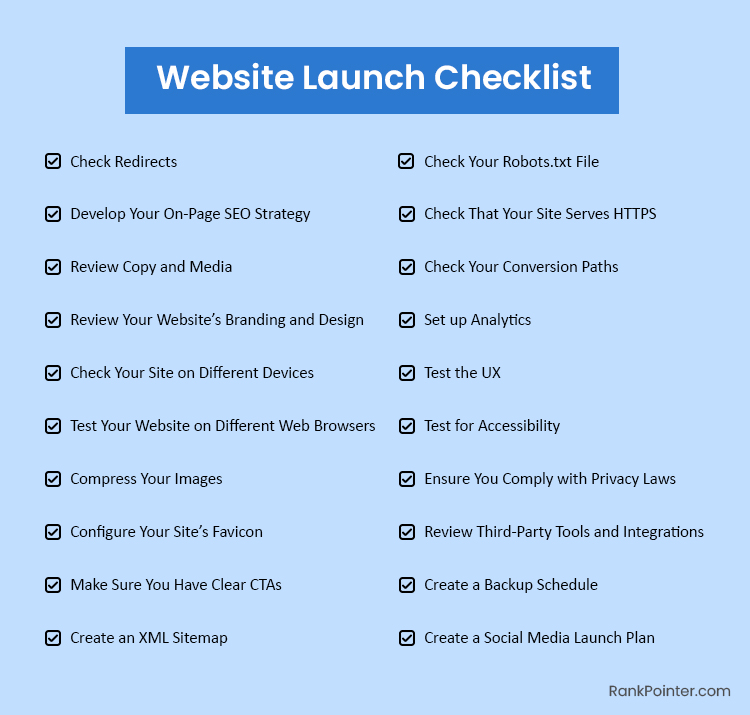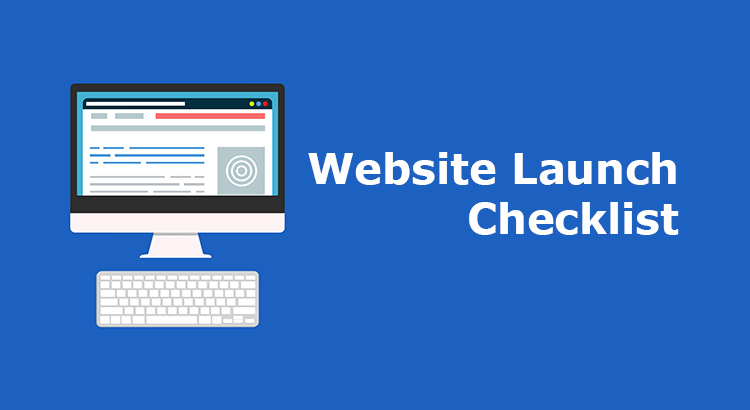Launching a website is a significant milestone for businesses. However, ensuring a successful website launch involves careful planning and execution. To assist you in this task, we present a comprehensive website launch checklist encompassing crucial tasks from pre-launch to post-launch phases.
Website Launch Checklist
The checklist for website launch is given below.
1. Check Redirects
Ensure seamless transition by redirecting old pages to new ones, maintaining user experience and search engine rankings. Implement 301 redirects for automatic redirection, preserving SEO value.
2. Develop Your On-Page SEO Strategy
Optimize webpage content with relevant keywords to improve visibility in search results, attracting organic traffic crucial for website success. Conduct keyword research to target audience intent effectively.
3. Review Copy and Media
Enhance user trust by ensuring error-free copy and high-quality media elements throughout the website, fostering a positive user experience. Verify spelling, grammar, and media display for consistency and professionalism.
4. Review Your Website’s Branding and Design
Maintain consistency in branding and design across all touchpoints, reinforcing brand identity and delivering a cohesive user experience. Ensure logo visibility, consistent typography, color scheme, and organized layout for brand recognition.
5. Check Your Site on Different Devices
Ensure optimal user experience across various devices to mitigate UX issues and maximize conversion rates. Use Google Dev Tools to assess site responsiveness and usability on different screen sizes.
6. Test Your Website on Different Web Browsers
Guarantee cross-browser compatibility to provide a consistent experience for all users. Test and address variations in appearance and functionality across different browsers, enhancing user satisfaction.
7. Compress Your Images
Improve website performance by compressing images without compromising quality, facilitating faster loading times and enhancing user experience. Utilize image compression tools to optimize file sizes efficiently.
8. Configure Your Site’s Favicon
Enhance brand recognition and professionalism by adding a favicon to browser tabs, reinforcing brand identity. Follow proper procedures to upload and configure the favicon for consistent branding across platforms.
9. Make Sure You Have Clear CTAs
Prompt user engagement and conversions with prominent and compelling calls-to-action, tailored to different audience segments. Design CTAs to stand out, personalize them, and create urgency for effective conversion optimization.
10. Create an XML Sitemap
Facilitate efficient search engine indexing by generating an XML sitemap, enhancing website visibility in search results. Submit the sitemap to search engines for comprehensive site crawling and indexing.
11. Check Your Robots.txt File
Ensure search engine crawlers can access and index website content effectively by reviewing and optimizing the robots.txt file. Verify accessibility settings and page permissions for optimal search engine visibility.
12. Check That Your Site Serves HTTPS
Safeguard user data transmission and enhance security by implementing HTTPS protocol, essential for modern websites. Verify SSL certificate installation and configuration for secure data exchange.
13. Check Your Conversion Paths
Streamline conversion processes by testing all pathways, minimizing obstacles, and maximizing conversion rates. Optimize form fields, checkout processes, and account registrations for improved user experience and higher conversions.
14. Set up Analytics
Gain valuable insights into user behavior and website performance by setting up analytics tools, informing data-driven decisions for optimization. Configure analytics tracking codes and verify data collection for accurate reporting.
15. Test the UX
Ensure a seamless user experience by validating all interactive elements and navigation pathways, enhancing user satisfaction and retention. Conduct usability tests to identify and address UX issues for improved website performance.
16. Test for Accessibility
Foster inclusivity by ensuring website accessibility features, catering to users with disabilities or technological constraints. Implement accessibility standards, such as alt text for images, to enhance usability for all users.
17. Ensure You Comply with Privacy Laws
Build user trust and mitigate legal risks by complying with privacy regulations, implementing best practices for data protection. Create cookie consent banners, privacy policies, and data breach response plans for regulatory compliance.
18. Review Third-Party Tools and Integrations
Enhance website performance by reviewing and optimizing third-party tools and integrations, improving user experience and search engine rankings. Remove unnecessary integrations and fix issues with existing tools for streamlined functionality.
19. Create a Backup Schedule
Ensure data integrity and continuity by establishing a backup schedule, safeguarding against data loss and website downtime. Determine backup frequency based on site update frequency and store backups securely for reliable data restoration.
20. Create a Social Media Launch Plan
Generate excitement and anticipation by crafting a comprehensive social media launch plan, maximizing visibility and engagement before, during, and after the website launch. Plan content distribution across platforms for effective promotion and audience engagement.

Conclusion of Website Launch Checklist
Launching a website is not just about going live; it’s about setting up a strong foundation for long-term success. By carefully planning and executing the tasks outlined in this checklist, you can ensure a smooth and successful website launch.


